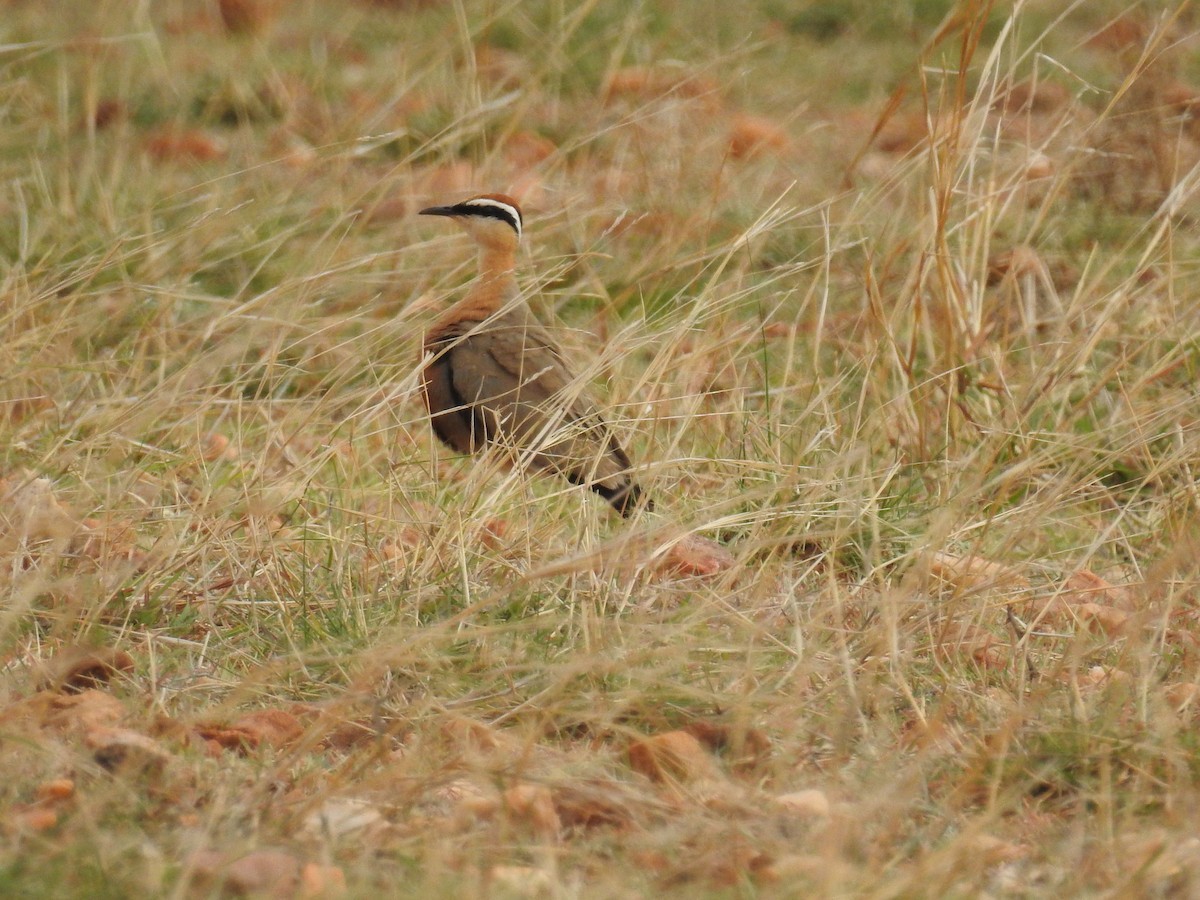Indian Courser
A species of Typical Coursers Scientific name : Cursorius coromandelicus Genus : Typical Coursers
Indian Courser, A species of Typical Coursers
Botanical name: Cursorius coromandelicus
Genus: Typical Coursers
Content
Description General Info
 Photo By Ashwin Viswanathan
Photo By Ashwin Viswanathan Description
This courser is widespread in South Asia and overlaps with some other species such as the similar looking cream-colored courser. This species is however brighter coloured than the cream-coloured courser and has a broader black eye-stripe that begins at the base of the beak. The crown is chestnut and the breast is rufous. The nape has a dark black patch where the long longer feathers forming the white stripe meet. In flight, the rump appears white and the wing tip is not as contrastingly black as in the cream-coloured courser. The sexes are alike. The long legs are whitish and as in other coursers have only three forward pointing toes. The species is closely related to other coursers in the region and are considered to form a superspecies with Cursorius cursor, Cursorius rufus and Cursorius temminckii. 
Size
26 cm
Nest Placement
Ground
Feeding Habits
Indian Courser predominantly consumes insects like beetles, grasshoppers, and ants, along with some small mollusks. It employs a run-and-peck technique to catch prey and may forage alone or in groups post-breeding season, occasionally joining C. cursor.
Habitat
The indian Courser predominantly inhabits arid to semi-arid regions characterized by dry stony plains and salty wastes. It is commonly found in human-modified landscapes such as waste and fallow lands with sparse vegetation, ploughed fields, as well as overgrazed grasslands and bare pastures often near human settlements. This species typically avoids regions receiving heavy rainfall.
Dite type
Granivorous
General Info
Feeding Habits
Bird food type
Behavior
These birds are usually seen in small flocks. They are usually found where the grass is not taller than them, since the tall grass blocks their view. They feed on insects mainly termites, beetles, crickets and grasshoppers picked up from the ground in stubbly or uncultivated fields. They run in spurts on the ground but take to flight with a hoarse creaky gwaat call. The flight is strong with rapid wing beats. They fly low and begin to run after landing. They breed mainly from March to August. Records exist from mid May in southern India and Sri Lanka and mid April in Darbhanga. They nest in a scrape on bare stony ground laying 2 or 3 speckled and well-camouflaged eggs that are very spherical. The chicks are protectively coloured and on alarm crouch and remain immobile making them extremely difficult to spot. Adults do not call or display when the nest or chicks are approached. The chicks are able to move upon hatching but are initially fed by the parents and begin to forage on their own after a week. 
Distribution Area
This species occurs in dry stony, scrubby or rocky country but rarely on sandy terrain from the Indus valley east short of Bangladesh and south to the tip of Peninsular India. It sometimes occurs in the dry zone of northern Sri Lanka. The wet forest zones are avoided. In southern India, the drier zone on the east coast, the Coromandel region, where it is not uncommon gives it the species name. It is also found patchily distributed in other parts of the peninsula. Other areas where they are commonly seen include the Deccan plateau and the arid regions of northwestern India in Rajasthan and Gujarat. It is resident in some areas but makes local movements. 
Species Status
The arid and open habitats used by the Indian courser are threatened by human activities such as construction and agriculture. In parts of Gujarat, the species was very common in short-grass covered open and fallow lands but has vanished in many areas. In some areas, vehicular activity and industrialization have destroyed habitats where they formerly occurred. 

 Photo By Ashwin Viswanathan
Photo By Ashwin Viswanathan Scientific Classification
Phylum
Chordates Class
Birds Order
Shorebirds Family
Pratincoles and coursers Genus
Typical Coursers Species
Indian Courser